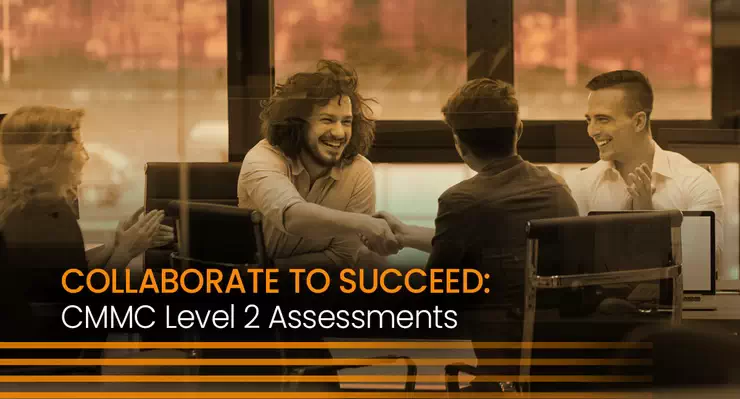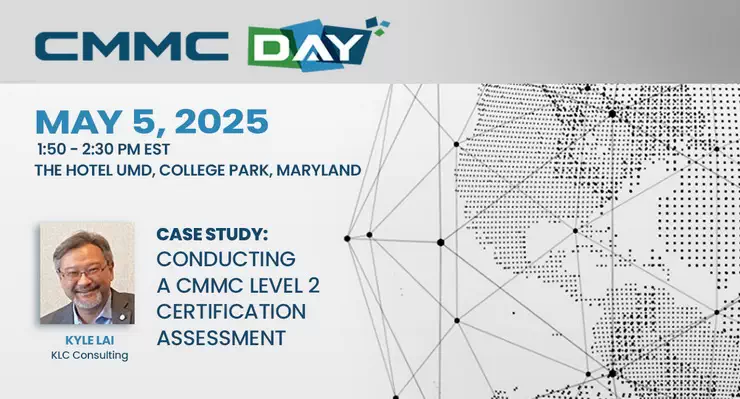
Introduction
In a recent podcast interview, Kyle Lai CCA, the President and CISO of KLC Consulting, sat down with Bobby Guerra and Kaleigh Floyd from Axiom.Tech’s Climbing Mount CMMC. Hear Kyle provide background on strategies for software compliance, document coordination and preparedness, and choosing the right C3PAO for your CMMC Level 2 Assessment. This post distills insights from Climbing Mount CMMC’s “Securing Custom Software: Documenting Software Security Controls for CMMC Compliance” podcast episode, emphasizing the necessity of collaboration in a successful CMMC Level 2 Certification Assessment.
The Maturing CMMC Landscape and the Assessment Process
The CMMC landscape is continuously evolving, and as more CMMC Level 2 assessments are conducted, the processes are becoming clearer. While there are still refinements happening behind the scenes with systems like the DoD’s eMASS, the overall framework established by the Cyber AB and the DoD provides a solid foundation. Organizations undergoing assessment can expect a structured approach involving initial scoping and evidence presentation, followed by a detailed evaluation against the 320 assessment objectives.
A key aspect of the CMMC Level 2 certification process is the requirement for at least two Certified CMMC Assessors (CCAs), along with a quality assurance (QA) component. This multi-layered approach ensures thoroughness and accuracy in the evaluation.
Navigating the Initial Hurdles: Avoiding “False Starts” in Your CMMC Journey
Understanding the initial phases of a CMMC Level 2 assessment is crucial to avoid “false starts.” Phase one involves scoping and evidence presentation, while phase two dives into the detailed assessment objectives. A “false start” occurs when an organization isn’t adequately prepared, often lacking a comprehensive System Security Plan (SSP). Kyle notes that early adopters undergoing assessments have generally been well-prepared, leading to successful certifications.
A significant aspect of the assessment process is the 10-business-day window to address any identified deficiencies that don’t impact other controls. This period can be a key opportunity for organizations to rectify minor oversights and achieve certification without the need for a complete reassessment. However, it’s vital to understand that this remediation period has limitations and isn’t a substitute for thorough preparation.
The Human Factor and the Importance of Preparation
While CMMC aims for a high level of security, it’s essential to acknowledge the human element. Mistakes can happen, and the 10-day remediation window offers some flexibility for minor errors. However, negligence or significant control gaps will likely necessitate a Plan of Action and Milestones (POA&M) and potentially a conditional certification. The key takeaway is that serious preparation, including internal walk-throughs or mock assessments conducted by experienced professionals, significantly increases the likelihood of a smooth and successful CMMC Level 2 assessment.
Focusing on Software Development: A Critical Aspect of CMMC Level 2
Given the increasing reliance on software within the DoD supply chain, ensuring its security is paramount. Organizations that develop software handling Controlled Unclassified Information (CUI) face unique challenges during their CMMC Level 2 assessment.
Overcoming the “Echo Chamber” and Ensuring Readiness
A common pitfall for organizations preparing for CMMC Level 2 certification is the “echo chamber” effect. Internal teams, deeply involved in their day-to-day operations, may inadvertently overlook critical security aspects. Engaging an external third party for a readiness review or a mock assessment can provide an objective perspective, identifying potential gaps that internal teams might miss.
Bridging the Communication Divide Between IT and Software Teams
One of the significant challenges in achieving CMMC compliance for software companies is the frequent disconnect between IT and software development teams. Often, network diagrams and security documentation lack a comprehensive view of the software infrastructure, including critical components like web application firewalls, API managers, and load balancers. Kyle emphasizes the urgent need for these teams to collaborate, ensuring that all relevant software assets and their security controls are accurately documented within the System Security Plan (SSP).
The reasons for this disconnect often stem from the specialized nature of each team’s expertise. Software development teams focus on code creation and functionality, while IT teams manage the underlying infrastructure. Without proactive communication, critical security considerations specific to the software development lifecycle (SDLC) and the software environment can be overlooked during CMMC Level 2 assessment.
The Value of Third-Party Expertise in Software-Focused Assessments
Engaging a third-party consulting organization with specific expertise in software assessment can be invaluable. These experts possess the knowledge to ask the right questions and identify potential vulnerabilities or documentation gaps that internal teams might not recognize. While the cost of consulting can vary, early engagement and thorough preparation by the organization can significantly reduce expenses.
Organizations can maximize the value of consulting by first documenting their software development architecture, including data flow and system components. Providing this detailed information upfront allows consultants to offer targeted and efficient guidance, potentially turning weeks of discovery into a focused half-day discussion.
Leveraging Existing Software Documentation for CMMC Compliance
Organizations that have robust Software Requirements Specifications (SRS) and software reference architectures are at an advantage in their CMMC compliance journey. These documents often contain critical information about identity requirements, access control, encryption, and data flow, which directly align with many NIST 800-171 software development requirements and CMMC Level 2 assessment criteria.
Understanding what “right looks like” in terms of documentation is also beneficial. While templates and examples can be helpful, tailoring documentation to the organization’s specific environment and practices is crucial. Often, network diagrams lack a dedicated section detailing the software infrastructure, including web servers, repositories, and other essential components.
Understanding CUI in the Software Development Lifecycle
A fundamental aspect of CMMC compliance for software companies is identifying whether the software being developed or the data it handles is considered CUI. This determination is typically outlined in the contract. If source code or the development environment itself handles CUI, then it falls within the scope of the CMMC Level 2 assessment.
Auditors will scrutinize the entire software development pipeline, from code repositories (like Git) to the deployment process (DevOps). Understanding and documenting the security controls implemented at each stage, including change management procedures, is essential for demonstrating compliance.
The Auditor’s Perspective: Understanding Your Processes
It’s pivotal to recognize that auditors primarily assess the organization’s documented processes and their implementation. While a C3PAO like KLC Consulting brings extensive experience, they rely on the organization to accurately represent their software development practices and security controls. Therefore, clear and comprehensive documentation, coupled with the ability to articulate these processes, is paramount for a successful CMMC Level 2 certification. Choosing a C3PAO with a strong understanding of software development ensures that the assessment team asks the relevant questions and can effectively evaluate your environment.
Common Challenges in Assessing Software Development Environments
One of the main challenges in assessing organizations with significant software development operations is ensuring the right personnel are involved in the assessment process. Often, companies may not initially include their development teams, leading to surprises when auditors inquire about software-specific security controls. It’s vital to have representatives from the software development and management teams available to address these questions.
Another challenge arises when the functionality and complexity of the developed software extend beyond the initial documentation. For instance, APIs provided to customers may introduce unique security considerations that need to be thoroughly examined. Inadequate documentation of software configurations is another common issue that can lead to delays or findings during the CMMC Level 2 assessment.
The Importance of a Detailed System Security Plan (SSP) for Software
A well-defined System Security Plan (SSP) is the cornerstone of CMMC compliance for software companies. It should comprehensively address all applicable security controls for the entire environment, including all software development assets. This includes detailing access controls for development tools, authentication mechanisms, and authorization processes. Treating software components as critical assets, just like hardware, ensures that all relevant security requirements are considered and documented.
Vulnerability Management in the Software Development Lifecycle
A significant tool for securing software development environments is vulnerability management. This goes beyond traditional IT vulnerability scanning and includes practices like static code analysis to identify vulnerabilities in the source code itself, as well as dynamic analysis to assess running applications for potential weaknesses like cross-site scripting. Establishing clear frequencies for these scans and having well-defined remediation processes are essential for demonstrating CMMC compliance. Collaboration between IT departments and software security teams, through a DevSecOps approach, is vital to ensure comprehensive vulnerability management across the entire organization.
Reducing Risk Through Strategic Practices and Cloud Leveraging
Organizations can strategically reduce their risk and streamline their CMMC compliance efforts in software development by leveraging FedRAMP-authorized cloud platforms and services. Platforms like Azure, AWS, and Google Cloud often inherit numerous security controls, reducing the burden on the organization. Similarly, utilizing services like SharePoint and potentially Power BI within government cloud environments can offer inheritance benefits. Implementing practices like single sign-on can also centralize security management and logging, simplifying compliance.
Prepare for Your CMMC Level 2 Certification Assessment!
Proper CMMC Level 2 Certification preparation is a critical undertaking for any organization that handles CUI and wishes to do business with the DoD. KLC Consulting, Inc., is committed to providing comprehensive CMMC Level 2 Certification assessment services. Download our free CMMC Level 2 Readiness Checklist to prepare for your assessment. Contact us to schedule your assessment and ensure your organization is prepared for the evolving cybersecurity landscape.
About KLC Consulting
KLC Consulting is an Authorized C3PAO specializing in conducting CMMC assessments and providing NIST 800-171 compliance solutions for the Defense Industrial Base (DIB). With over two decades of experience and a team of Cyber AB-authorized Lead Certified CMMC Assessors, KLC Consulting delivers objective, high-quality CMMC Level 2 assessments and readiness services for organizations ranging from Fortune 500s to small subcontractors. Read more about us here.



